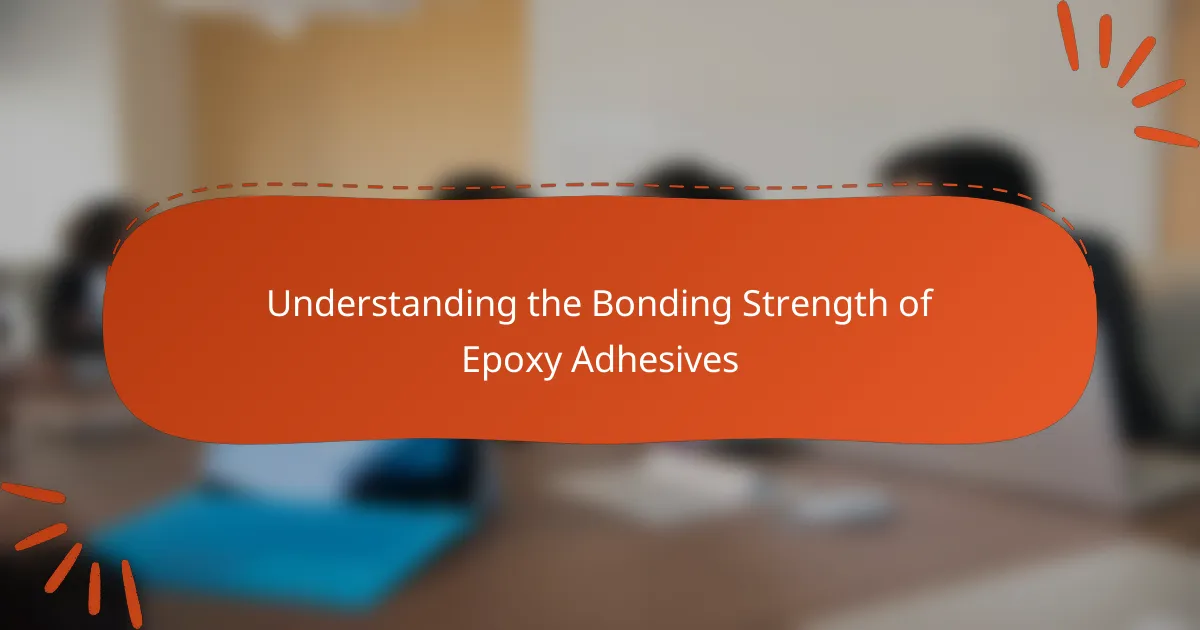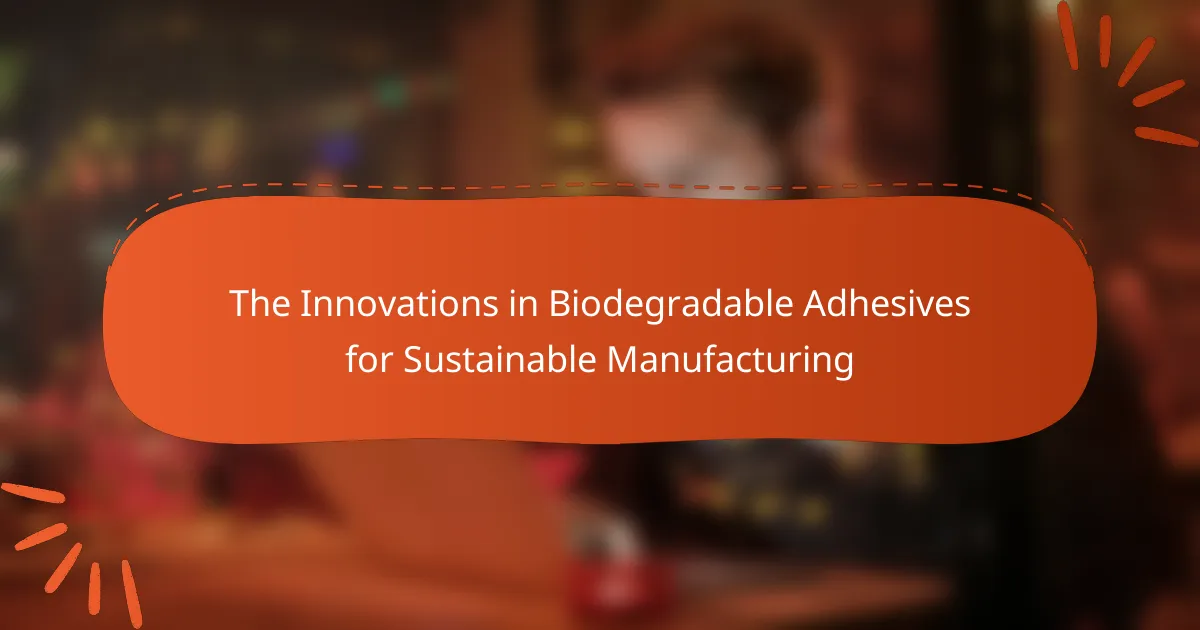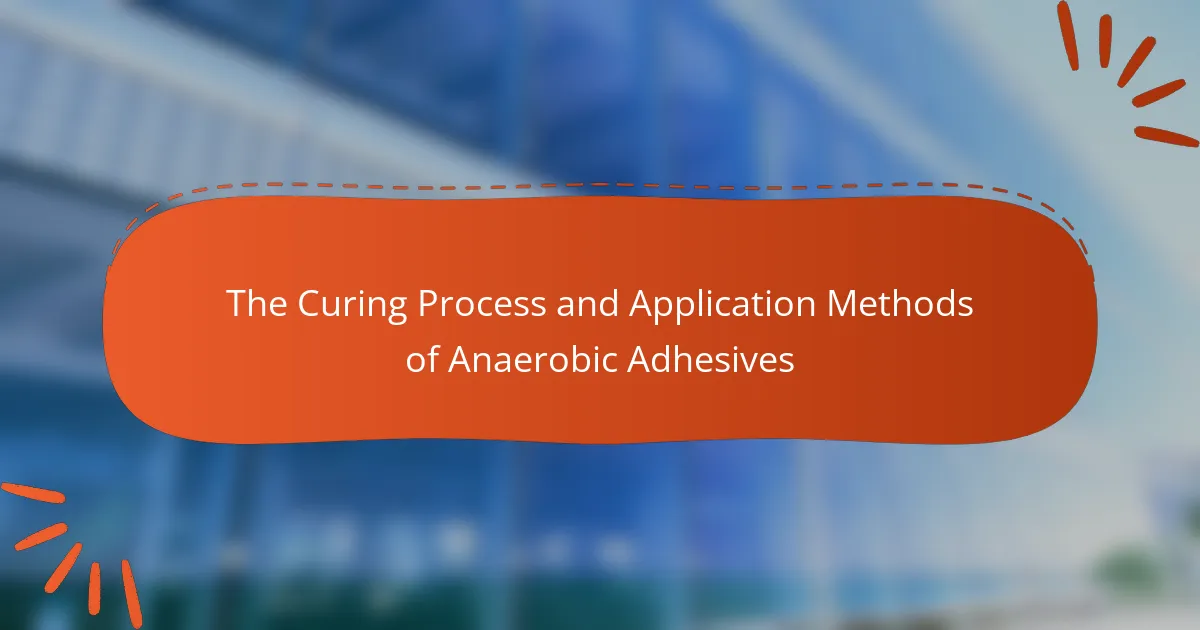Epoxy adhesives are durable bonding agents formed by mixing epoxy resin and hardener, resulting in a strong chemical bond. This article explores the key attributes of epoxy adhesives, including adhesion, cohesion, durability, and temperature resistance, which contribute to their effectiveness in various applications such as construction, automotive, aerospace, and electronics. It also emphasizes the importance of surface preparation, proper mixing ratios, and environmental conditions for optimal performance. Additionally, the article highlights safety precautions necessary for handling epoxy adhesives, ensuring users are informed about best practices for effective use.
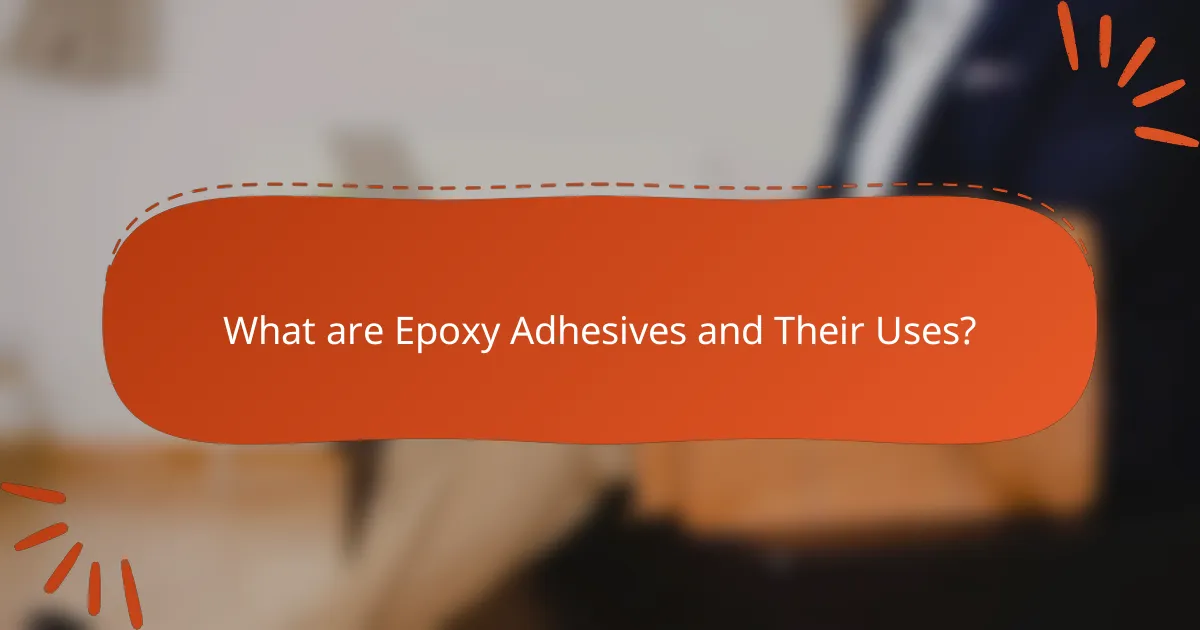
What are Epoxy Adhesives and Their Uses?
Epoxy adhesives are strong, durable adhesives made from a combination of epoxy resin and hardener. They create a chemical bond when the resin and hardener are mixed together. This bonding process results in a robust and resilient material. Epoxy adhesives are used in various applications, including construction, automotive, aerospace, and electronics. They are ideal for bonding metals, plastics, glass, and wood. Their resistance to heat, chemicals, and moisture enhances their versatility. Epoxy adhesives can fill gaps and provide structural integrity. Their curing time can vary, allowing for flexibility in application.
How do Epoxy Adhesives differ from other adhesives?
Epoxy adhesives differ from other adhesives primarily in their chemical composition and bonding strength. They consist of a resin and a hardener that chemically react to form a strong bond. This chemical reaction creates a durable and rigid structure upon curing. In contrast, many other adhesives rely on physical bonding mechanisms, such as pressure-sensitive adhesion or solvent evaporation.
Epoxy adhesives offer superior resistance to heat, chemicals, and moisture compared to most conventional adhesives. Their bonding strength is often significantly higher, making them suitable for demanding applications. For instance, epoxy adhesives can withstand temperatures up to 150°C, while many other adhesives may fail at lower temperatures.
Additionally, epoxy adhesives can bond a wider variety of materials, including metals, plastics, and ceramics. This versatility is less common in other adhesive types, which may be limited to specific materials. The unique properties of epoxy adhesives make them a preferred choice in industries such as aerospace, automotive, and construction.
What are the main components of Epoxy Adhesives?
The main components of epoxy adhesives are resin and hardener. The resin is typically a bisphenol A or bisphenol F compound. The hardener is often an amine or an anhydride. When mixed together, these components undergo a chemical reaction. This reaction forms a strong bond as the epoxy cures. Epoxy adhesives are known for their excellent bonding strength and durability. They can adhere to a variety of materials including metals, plastics, and wood. The specific formulation can vary based on the intended application.
What types of Epoxy Adhesives are available?
There are several types of epoxy adhesives available. These include standard epoxy adhesives, which are versatile and used for general bonding. There are also fast-setting epoxy adhesives, designed for quick curing times. Flexible epoxy adhesives allow for some movement in bonded materials. High-temperature epoxy adhesives can withstand extreme heat conditions. Structural epoxy adhesives are used for heavy-duty applications requiring strong bonds. Additionally, there are marine epoxy adhesives formulated for underwater use. Each type serves specific applications based on their unique properties and performance characteristics.
Why is Bonding Strength important in Epoxy Adhesives?
Bonding strength is crucial in epoxy adhesives because it determines the effectiveness of the adhesive in joining materials. High bonding strength ensures that the adhesive can withstand stress, load, and environmental factors without failing. This is particularly important in construction and manufacturing applications where structural integrity is vital. For instance, epoxy adhesives can achieve bonding strengths exceeding 3000 psi, making them suitable for heavy-duty applications. Additionally, strong bonds reduce the likelihood of delamination or separation over time. Therefore, the bonding strength of epoxy adhesives directly impacts their performance and reliability in various applications.
How is Bonding Strength measured in Epoxy Adhesives?
Bonding strength in epoxy adhesives is measured using tensile strength tests. These tests determine the maximum load the adhesive can withstand before failure. A common method involves bonding two substrates together and applying a tensile force until separation occurs. The force at which the bond fails is recorded as the bonding strength.
Typically, bonding strength is expressed in units like pounds per square inch (psi) or megapascals (MPa). According to ASTM D1002, a standard test method for measuring the adhesive bond strength, results can vary based on factors such as surface preparation and curing conditions.
Testing can also be conducted at different temperatures and environmental conditions to assess performance under varying scenarios. This comprehensive approach ensures accurate evaluation of the adhesive’s bonding capabilities.
What factors influence the Bonding Strength of Epoxy Adhesives?
The bonding strength of epoxy adhesives is influenced by several key factors. These factors include surface preparation, curing conditions, and the specific formulation of the epoxy. Proper surface preparation enhances adhesion by removing contaminants and increasing surface area. Curing conditions, such as temperature and humidity, significantly affect the chemical reaction and final properties of the adhesive. Additionally, the formulation, including filler types and ratios, can modify the adhesive’s mechanical properties. Research indicates that optimal curing temperature typically ranges from 20°C to 25°C for maximum strength. Studies show that well-prepared surfaces can improve bonding strength by up to 50%.
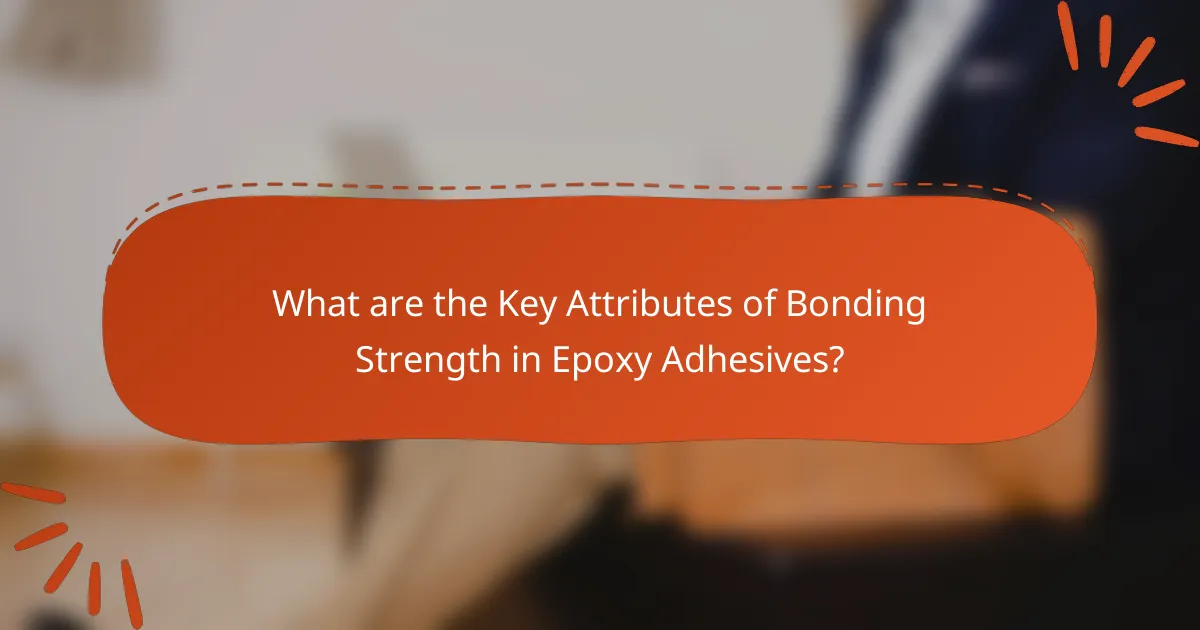
What are the Key Attributes of Bonding Strength in Epoxy Adhesives?
The key attributes of bonding strength in epoxy adhesives include adhesion, cohesion, durability, and temperature resistance. Adhesion refers to the ability of the epoxy to bond with various substrates. Cohesion indicates the internal strength of the adhesive itself. Durability measures the resistance to environmental factors such as moisture and chemicals. Temperature resistance defines the epoxy’s performance under varying thermal conditions. These attributes collectively determine the effectiveness and reliability of epoxy adhesives in bonding applications.
What role does surface preparation play in Bonding Strength?
Surface preparation significantly enhances bonding strength in epoxy adhesives. Proper preparation removes contaminants and creates a suitable texture for adhesion. This process increases the surface area for the adhesive to bond effectively. Studies show that well-prepared surfaces can improve bond strength by up to 50%. Techniques such as sanding, cleaning, or etching are commonly used for preparation. These methods ensure optimal contact between the adhesive and the substrate. Inadequate surface preparation can lead to weak bonds and premature failure. Therefore, effective surface preparation is crucial for maximizing the performance of epoxy adhesives.
How does surface roughness affect Bonding Strength?
Surface roughness significantly influences bonding strength in epoxy adhesives. Increased surface roughness enhances mechanical interlocking between the adhesive and substrate. This interlocking leads to improved adhesion and higher bond strength. Studies indicate that rougher surfaces can increase the surface area for bonding. For instance, a study published in the “Journal of Adhesion Science and Technology” by Lee et al. (2018) found that a roughness average (Ra) of 1.5 µm resulted in a bond strength increase of 30% compared to a smooth surface. Therefore, optimizing surface roughness is crucial for maximizing the effectiveness of epoxy adhesives.
Why is cleanliness critical for optimal Bonding Strength?
Cleanliness is critical for optimal bonding strength because contaminants can weaken the adhesive bond. Dust, oil, and moisture can create barriers between the adhesive and substrate. These barriers prevent proper adhesion and can lead to bond failure. Studies show that surfaces prepared with cleaning agents result in stronger bonds. For example, a study published in the Journal of Adhesion Science and Technology found that clean surfaces had up to 50% higher bonding strength. Proper surface preparation enhances molecular contact, improving the overall bond integrity. Thus, maintaining cleanliness is essential for achieving reliable and durable adhesive performance.
How does curing time impact Bonding Strength?
Curing time significantly impacts bonding strength in epoxy adhesives. Longer curing times generally lead to higher bonding strength. This occurs because the chemical reactions that create cross-linking in the epoxy continue to progress over time. Increased cross-linking enhances the adhesive’s structural integrity. Research indicates that optimal curing times can vary between 24 to 72 hours for maximum strength. For instance, a study by P. K. Gupta et al. in the Journal of Adhesion Science and Technology shows that epoxy adhesives achieve peak bonding strength after 48 hours of curing. Thus, proper curing time is crucial for achieving the desired bonding performance in epoxy adhesives.
What are the different curing methods for Epoxy Adhesives?
Epoxy adhesives can be cured using several methods. The primary curing methods include ambient temperature curing, heat curing, and chemical curing. Ambient temperature curing occurs at room temperature and relies on the chemical reaction between the resin and hardener. Heat curing involves applying elevated temperatures to accelerate the curing process, enhancing the adhesive’s final properties. Chemical curing uses additional curing agents or catalysts to initiate the curing process. Each method influences the adhesive’s performance, strength, and application suitability. For instance, heat curing often results in stronger bonds compared to ambient curing.
How does temperature affect the curing process and Bonding Strength?
Temperature significantly influences the curing process and bonding strength of epoxy adhesives. Higher temperatures generally accelerate the curing reaction, leading to faster hardening. This can result in improved initial bonding strength. Conversely, low temperatures can slow the curing process, potentially leading to incomplete curing and weaker bonds.
Research shows that optimal curing temperatures usually range from 20°C to 30°C for most epoxy formulations. At these temperatures, the chemical reactions proceed efficiently, maximizing the adhesive’s performance. Deviations from this range can lead to suboptimal results. For instance, curing at temperatures below 10°C may result in insufficient cross-linking, reducing overall strength.
In summary, maintaining appropriate temperature conditions during the curing of epoxy adhesives is crucial for achieving maximum bonding strength.
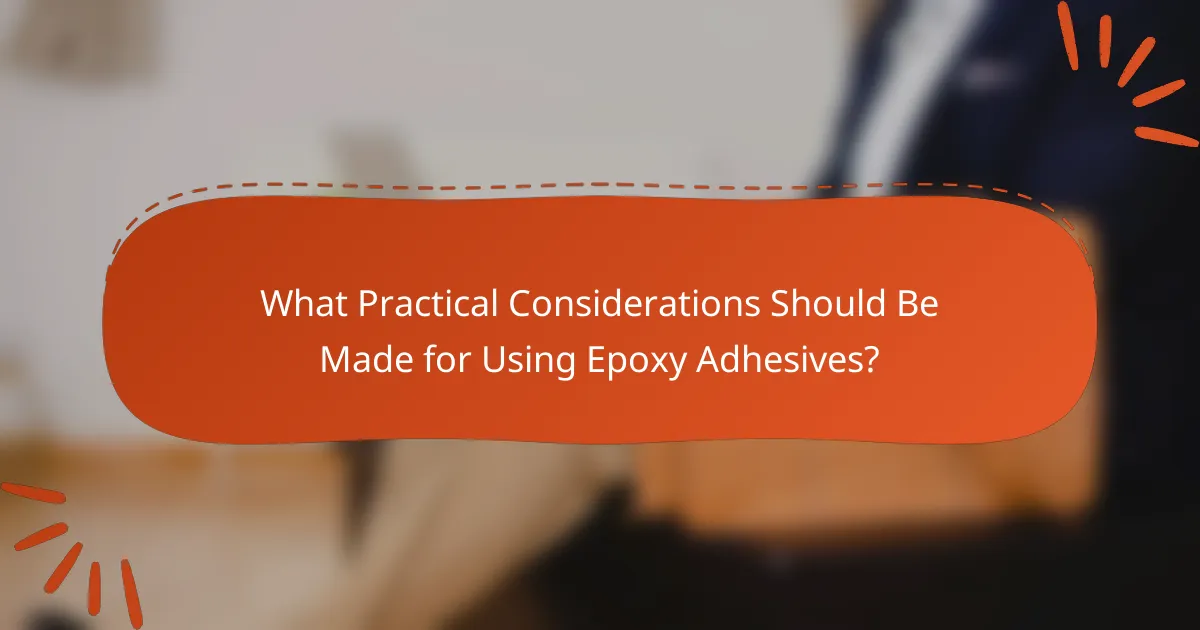
What Practical Considerations Should Be Made for Using Epoxy Adhesives?
Epoxy adhesives require careful consideration for effective use. First, surface preparation is crucial. Clean and roughen surfaces to enhance adhesion. Second, proper mixing ratios are essential. Follow manufacturer instructions for optimal bonding strength. Third, temperature affects curing time. Ideal application temperatures range from 60°F to 90°F. Fourth, curing time varies by formulation. Some epoxies cure in minutes, while others take hours. Fifth, consider the environmental conditions. Humidity can impact the adhesive’s performance. Lastly, safety precautions are vital. Use gloves and work in a well-ventilated area to avoid harmful fumes.
What are the best practices for applying Epoxy Adhesives?
The best practices for applying epoxy adhesives include surface preparation, mixing, application, and curing. First, clean the surfaces to remove dust, grease, or moisture. This ensures optimal adhesion. Next, accurately mix the resin and hardener according to the manufacturer’s instructions. Incorrect ratios can weaken the bond. Apply the mixed epoxy evenly using a suitable tool, ensuring full coverage. Avoid excessive thickness, as it can lead to longer curing times and potential weaknesses. Allow the adhesive to cure undisturbed for the recommended time, usually 24 hours for full strength. Maintain the recommended temperature and humidity levels during curing for optimal results. Following these practices enhances the bonding strength of epoxy adhesives significantly.
How can users ensure maximum Bonding Strength during application?
Users can ensure maximum bonding strength during application by following precise preparation and application techniques. First, surfaces must be clean, dry, and free of contaminants. This includes removing dust, grease, and old adhesive residues. Second, roughening the surfaces can enhance adhesion by increasing the surface area. Third, mixing the epoxy resin and hardener according to the manufacturer’s specifications is crucial. Incorrect ratios can weaken the bond. Fourth, applying the epoxy evenly and avoiding air bubbles is essential for a strong bond. Finally, allowing adequate curing time as specified by the manufacturer ensures the bond reaches its full strength. Research indicates that proper surface preparation and curing significantly improve adhesion performance in epoxy applications.
What common mistakes should be avoided when using Epoxy Adhesives?
Common mistakes to avoid when using epoxy adhesives include improper surface preparation. Surfaces should be clean, dry, and free of contaminants. Failing to mix the epoxy components correctly can lead to weak bonds. It is essential to follow the manufacturer’s mixing instructions precisely. Applying too much or too little adhesive can also compromise the bond strength. Using the adhesive outside its recommended temperature range can affect curing. Not allowing adequate curing time can result in incomplete bond formation. Lastly, neglecting to test the bond after curing can lead to unexpected failures.
How can users troubleshoot Bonding Strength issues in Epoxy Adhesives?
To troubleshoot bonding strength issues in epoxy adhesives, users should first ensure proper surface preparation. Surfaces must be clean, dry, and free of contaminants. This includes removing dirt, grease, and moisture. Next, verify that the mixing ratio of resin and hardener is accurate. Incorrect ratios can lead to weak bonds.
Users should also check the curing conditions. Epoxy adhesives require specific temperature and humidity levels for optimal performance. If conditions are not met, bonding strength may be compromised. Additionally, evaluate the application method. Uneven application can result in inadequate adhesion.
Finally, inspect the age of the epoxy adhesive. Expired or improperly stored adhesives may not perform as expected. Following these steps can help users identify and resolve bonding strength issues effectively.
What signs indicate a failure in Bonding Strength?
Signs indicating a failure in bonding strength include visible separation of bonded surfaces. This separation often manifests as gaps or delamination between the materials. Discoloration at the bond line can also signal potential failure. Additionally, a decrease in mechanical strength may be observed during stress testing. Surface roughness or irregularities can compromise adhesion. Environmental factors, such as moisture or temperature fluctuations, can exacerbate bonding issues. These signs are critical for assessing the integrity of epoxy adhesive applications.
What steps can be taken to improve Bonding Strength after application?
To improve bonding strength after application, ensure proper surface preparation. Clean surfaces to remove contaminants like dust and grease. Roughening the surface can enhance mechanical interlocking. Apply heat to cure the epoxy more effectively, as elevated temperatures can increase bond strength. Use a primer specifically designed for epoxy adhesives to enhance adhesion. Ensure adequate curing time as insufficient curing can weaken the bond. Monitor environmental conditions, as humidity and temperature can affect curing. Finally, consider applying pressure during the curing process to improve contact between surfaces.
Epoxy adhesives are strong and durable bonding agents composed of epoxy resin and hardener, known for their superior bonding strength and resistance to heat, chemicals, and moisture. This article explores the fundamental aspects of epoxy adhesives, including their composition, types, and the critical role of bonding strength in various applications. Key factors influencing bonding strength, such as surface preparation, curing conditions, and cleanliness, are examined, alongside best practices for application and common troubleshooting methods. The discussion emphasizes the importance of understanding bonding strength to ensure effective and reliable use of epoxy adhesives in diverse industries.
